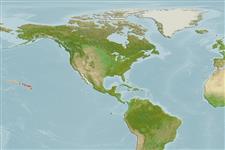Klassifizierung / Names
Namen | Synonyme | Catalog of Fishes(Gattung, Arten) | ITIS | CoL | WoRMS | Cloffa
Environment: milieu / climate zone / depth range / distribution range
Ökologie
seewasser riff-verbunden; tiefenbereich 26 - 68 m (Ref. 10382). Tropical
Eastern Central Pacific: Hawaii and Johnston Island.
Size / Gewicht / Alter
Maturity: Lm ? range ? - ? cm
Max length : 7.7 cm SL Männchen/unbestimmt; (Ref. 10382)
Rückenflossenstacheln (insgesamt) : 10; Rückenflossenweichstrahlen (insgesamt) : 16 - 18; Afterflossenstacheln: 3; Afterflossenweichstrahlen: 9 - 10. This species has the following characters: body depth 2.6-2.95 in SL; scaled lower jaw; absence of fleshy papillae on edge of orbit; upper edge of preopercle finely serrate while the lower edge is smooth; margin of subopercle serrate while interopercle has 0-4 serrae; in males the front of upper lip is not thickened nor pointed and the anterior soft part of the anal fin more prolonged, fourth anal soft ray longest; caudal fin deeply emarginate with filamentous lobes; pelvic fins long, very long in males; colour of females yellow dorsally, shading on body to lavender-pink, but scale centers yellow; head yellow with pink to magenta lines; fins are yellow, the dorsal and anterior anal fin with magenta margin; color of head of males similar to females but body orange with red scale centers, changing to violet posteriorly; dorsal and anal fins are mainly orange, abruptly pale yellow posteriorly; a large magenta-edged yellow spot at base of pectoral fins (Ref. 86689).
Life cycle and mating behavior
Maturities | Fortpflanzung | Spawnings | Egg(s) | Fecundities | Larven
Randall, J.E., 1979. A review of the serranid fish genus Anthias of the Hawaiian Islands, with descriptions of two new species. Contrib. Sci. Natur. Hist. Mus. Los Angeles County 302:1-13. (Ref. 10382)
IUCN Rote Liste Status (Ref. 130435)
Bedrohung für Menschen
Harmless
Nutzung durch Menschen
Tools
Zusatzinformationen
Download XML
Internet Quellen
Estimates based on models
Phylogenetic diversity index (Ref.
82804): PD
50 = 0.5000 [Uniqueness, from 0.5 = low to 2.0 = high].
Trophic level (Ref.
69278): 3.3 ±0.4 se; based on size and trophs of closest relatives
Widerstandsfähigkeit (Ref.
120179): hoch, Verdopplung der Population dauert weniger als 15 Monate. (Preliminary K or Fecundity.).
Fishing Vulnerability (Ref.
59153): Low vulnerability (10 of 100).
